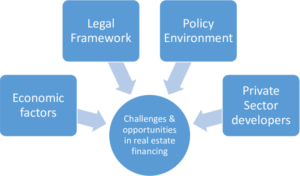I. Introduction
Real estate financing is the cornerstone of turning the dream of homeownership into a tangible reality. Navigating the diverse landscape of real estate loans requires a deep understanding of the various financing options available. In this comprehensive guide, we will explore the intricacies of real estate financing, shedding light on different types, factors influencing decisions, and providing valuable tips for a successful financial journey.

II. Types of Real Estate Financing
A. Conventional Mortgage Options
1. Fixed-rate Mortgages: Stability Amidst Uncertainty
Fixed-rate mortgages offer stability with consistent interest rates throughout the loan term, providing predictability for budget-conscious individuals. Borrowers can plan their finances with confidence, knowing that their monthly payments will remain constant.
2. Adjustable-rate Mortgages: Navigating Market Fluctuations
Suited for those comfortable with market fluctuations, adjustable-rate mortgages (ARMs) come with lower initial interest rates that may change over time. ARM borrowers benefit when interest rates decrease but face increased payments if rates rise.
B. Government-Backed Loan Programs
1. FHA Loans: Accessible and Inclusive
Backed by the Federal Housing Administration, FHA loans are accessible to a broader range of borrowers, often requiring lower down payments and accommodating lower credit scores. This makes homeownership more achievable for individuals who may face challenges with traditional financing.
2. VA Loans: Exclusive Benefits for Veterans
Exclusive to veterans and military personnel, VA loans come with favorable terms, including zero down payment requirements. The VA’s guarantee to lenders allows veterans to secure financing with competitive interest rates and relaxed credit score requirements.
3. USDA Loans: Affordable Financing for Rural Homebuyers
Aimed at rural homebuyers, USDA loans provide affordable financing options with low-interest rates and minimal down payment requirements. These loans support the development of rural communities by making homeownership more attainable.

C. Alternative Financing Solutions
1. Seller Financing: Collaboration Between Buyer and Seller
In this unique arrangement, the seller becomes the lender, facilitating the purchase by financing part or all of the home price. Seller financing can be an attractive option for buyers facing challenges with traditional financing, offering flexibility in terms and conditions.
2. Lease Options: Renting with the Option to Buy
Lease options provide flexibility by allowing individuals to lease a property with the option to buy at a later date. This option gives potential buyers time to secure traditional financing while enjoying the benefits of living in the desired property.
III. Factors Shaping Real Estate Financing
A. Impact of Credit Scores and Financial Histories
A strong credit profile is a key determinant in accessing favorable loan terms. Regularly monitoring credit scores and taking steps to improve them can significantly enhance financing opportunities.
B. Evaluation of Down Payment Requirements
Understanding down payment requirements is crucial for effective budget planning. Higher down payments often lead to lower interest rates and more favorable loan terms, making it essential to save strategically.
C. Navigating Current Market Conditions
Economic factors and market trends can influence interest rates and financing options. Staying informed about current conditions empowers borrowers to make timely and well-informed decisions.

D. Understanding Interest Rates and APRs
Thoroughly comprehending the difference between interest rates and annual percentage rates (APRs) ensures borrowers are not caught off guard by additional costs. Comparing APRs allows for a more accurate assessment of the true cost of borrowing.
IV. Steps to Secure Real Estate Financing
A. Financial Preparation Strategies
Preparing personal finances involves organizing documents, assessing debt-to-income ratios, and ensuring a stable financial standing. Lenders often require detailed financial information to assess creditworthiness.
B. Researching and Comparing Lenders Effectively
Thorough research into various lenders, including banks, credit unions, and online lenders, helps identify the most suitable financing partner. Comparing interest rates, fees, and customer reviews aids in making an informed decision.
C. Importance of Securing Pre-Approval for a Mortgage
Securing pre-approval provides a clear picture of the loan amount individuals qualify for, streamlining the homebuying process. It also demonstrates to sellers that the buyer is a serious and qualified candidate.
D. In-Depth Comprehension of Loan Terms and Conditions
Understanding loan terms, including interest rates, loan duration, and potential fees, empowers borrowers to make informed choices. Reviewing and clarifying any uncertainties with the lender ensures transparency throughout the financing process.

V. Common Challenges in Real Estate Financing
A. Addressing Potential Loan Rejections
Facing a loan rejection is not uncommon and can be attributed to various factors. Strategies such as improving credit scores, reducing existing debts, and exploring alternative lenders can help overcome setbacks.
B. Strategies for Managing High-Interest Rates
High-interest rates can significantly impact the cost of homeownership. Strategies for managing this challenge include improving credit scores, exploring government-backed loans, and negotiating with lenders for better terms.
C. Navigating Economic Fluctuations and Their Impacts
Adapting to economic fluctuations involves staying informed about market trends, exploring fixed-rate mortgages for stability, and considering long-term financial strategies to withstand economic uncertainties.
VI. Tips for Successful Real Estate Financing
A. Building and Maintaining a Robust Credit Profile
Consistent efforts to build and maintain a strong credit profile enhance borrowing capacity and improve loan terms. Timely payment of debts and responsible financial management contribute to a positive credit history.
B. Saving Strategically for a Substantial Down Payment
Saving for a substantial down payment not only reduces the loan amount but also leads to more favorable interest rates. Creating a dedicated savings plan and exploring down payment assistance programs can aid in achieving this goal.
C. Seeking Guidance from Financial Advisors
Professional financial advice provides tailored solutions, ensuring borrowers make well-informed decisions aligned with their long-term financial goals. Financial advisors can offer insights into suitable financing options and help navigate complex financial situations.
D. Staying Informed About Evolving Market Trends
Being proactive in staying informed about market trends enables borrowers to anticipate changes and make strategic financial decisions. This includes monitoring interest rate movements, changes in housing market conditions, and updates in lending regulations.

VII. Real-life Case Studies
A. Success Stories Showcasing Effective Real Estate Financing Strategies
Real-life examples illustrate how individuals or businesses successfully navigated the challenges of real estate financing, providing inspiration for readers. These case studies showcase diverse strategies that led to successful homeownership experiences.
B. Lessons Learned from Challenges and Their Successful Resolutions
Highlighting challenges faced by individuals and how they strategically addressed and overcame obstacles in their real estate financing journey. These lessons learned provide valuable insights for readers encountering similar challenges.
VIII. Future Trends in Real Estate Financing
A. Embracing Technological Advancements in the Financing Sector
The integration of technology is revolutionizing the real estate financing landscape. From online mortgage applications to blockchain-based transactions, technological advancements are offering innovative solutions and streamlining the application process.
B. Anticipated Changes in Regulations and Their Influence on Real Estate Financing
Staying abreast of regulatory changes is crucial, as shifts in legislation can impact loan requirements, interest rates, and overall financing options. The evolving regulatory landscape requires borrowers to stay informed and adapt their strategies accordingly.

IX. Conclusion
In conclusion, real estate financing is a multifaceted journey that requires careful consideration and strategic planning. By understanding the different types of financing, factors influencing loan decisions, and adopting tips for success, individuals and businesses can embark on a successful real estate financing journey. With the right knowledge and preparation, the dream of homeownership becomes not only achievable but financially rewarding. Whether exploring traditional mortgage options or considering alternative financing solutions, the key is to approach real estate financing with diligence, foresight, and a commitment to financial success.
Frequently Asked Questions:
- What are the eligibility criteria for real estate financing?
- How does credit history impact the approval of a mortgage?
- What types of government-backed loans are available, and who qualifies for them?
- Are there alternative financing options for individuals with less-than-perfect credit?
- What factors should be considered when choosing between fixed-rate and adjustable-rate mortgages?
- How much should I save for a down payment, and are there assistance programs available?
- What steps can be taken to improve credit scores before applying for a mortgage?
- How do economic fluctuations affect interest rates in the real estate market?
- Are there specific considerations for financing investment properties?
- What documentation is required during the mortgage application process?

With years of experience in personal finance, Lina is dedicated to providing practical insights and guidance. Her expertise includes budgeting, investing, and next-gen financial strategies.






Leave a Reply